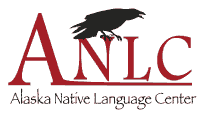Mapping Alaska's Native languages
by Gary Holton
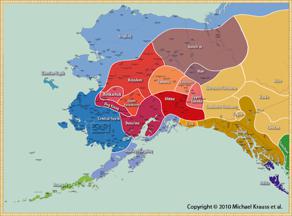 The most widely accepted map of Alaska Native languages is Michael Krauss' Native Peoples and Languages of Alaska (1974, revised 1982). In Alaska today the map is ubiquitous. It is found in nearly every government office
and school, and it has become ingrained on the public consciousness, both Native and
non-Native. The boundaries on the map have become so entrenched that they are often
assumed to be statements of undisputed fact akin to the location of a mountain or
a political boundary.
The most widely accepted map of Alaska Native languages is Michael Krauss' Native Peoples and Languages of Alaska (1974, revised 1982). In Alaska today the map is ubiquitous. It is found in nearly every government office
and school, and it has become ingrained on the public consciousness, both Native and
non-Native. The boundaries on the map have become so entrenched that they are often
assumed to be statements of undisputed fact akin to the location of a mountain or
a political boundary.
Language Relationships
Yet in truth the map represents the results of detailed linguistic analysis. There are no lines in the tundra separating one color from another. Language boundaries must be determined from the careful analysis of individual speech patterns, and the map is itself essentially a representation of the distribution of those speech patterns.
In order to discover these patterns, Krauss developed a detailed linguistic survey, largely focused on the pronunciation of certain sounds that vary in regular ways. One example that many people will be familiar with is the sound in the Eskimo/Inuit words for "person." The old Eskimo sound *ŋ is pronounced variously as n, ñ (ny), s, c (ch), or y. Thus, we find words for person such as inuk, iñuk, suk, cuk, and yuk. The geographic distribution of a particular linguistic feature is called an isogloss. A single isogloss is usually not sufficient to determine a language. For example, an isogloss of the pronunciation of the English words cot and caught shows that these words are pronounced identically in eastern New England, western Pennsylvania, Canada, and the American West. But the speakers of these regions do not represent a different language. Usually, more than one isogloss is required in order to define a language.
The real challenge comes when different isoglosses yield conflicting results. For example, the isogloss of regions where the three Proto-Athabaskan consonant series *ts, *ch, and *chw merge (are pronounced alike) includes all four dialects of Ahtna and the Upper inlet dialect of Dena'ina (as well as the Canadian languages Tagish, Babine-Witsuwit'en, and Tsuut'ina). Yet another isogloss cross-cuts this one. Namely, the region where the Proto-Athabaskan vowel system is reduced from seven vowels to four includes all dialects of Dena'ina as well as Deg Hit'an. The boundaries on the map reflect a greater importance attached to this second isogloss than to the first. It should not be forgotten, however, that Upper Inlet Dena'ina shares some properties with Ahtna and some properties with other Dena'ina dialects. Maps demand precision, whereas language boundaries are fuzzy.
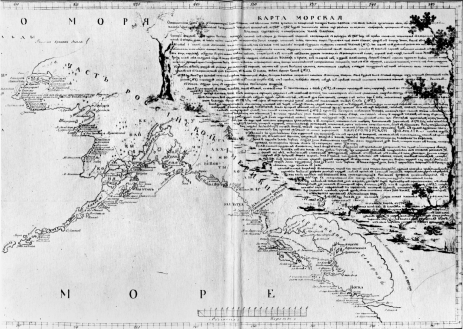 |
| Right section of Shelikhov's 1796 map (Krauss 2006) |
History
Krauss' map was not the first map of Alaska Native languages. That honor goes to Grigorii Ivanovich Shelikhov, an entrepreneur with the Russian-American company whose ethnolinguistic map of Alaska appeared in 1796. Shelikhov's map distinguishes five ethnolinguistic regions: KO-NIA-GI (Yup'ik / Alutiiq); KE-NAI=TSY (Dena'ina); CHU-GA-CHI (Sugpiaq); UGA-LAX-MIU-TY (Eyak); and KO-LIU-ZHI (Tlingit).
Aleut is omitted from the map, perhaps taken as a given by Shelikhov, as that was the language with which the Russians had had most contact.
 |
| Detail from Verman's 1863 map (Krauss 2006) |
The next language map of Alaska to appear was produced by a Russian naval officer, Fedor Karlovich Verman. It was published in color in 1863 and distinguishes six languages: Aleut, Eskimo, Tlingit, Ahtna, Kenai (Dena'ina), and Kolchan (referring to interior Athabascan languages other than Ahtna).
American maps produced by various authors in the late nineteenth century introduced many errors and are less accurate than those produced by Shelikhov and Verman. In any case, all of these maps focused primarily on the coastal areas. Not until the twentieth century did a detailed map of the Athabascan languages of the interior appear. Osgood's 1936 map lists only eight of the eleven Athabascan languages on Krauss' map. Missing on Osgood are Holikachuk, Tanacross, and Upper Kuskokwim. Osgood simply did not collect sufficient language information in order to distinguish these languages.
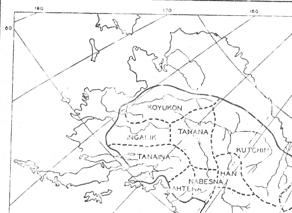 |
| Osgood 1936 map (Krauss 2006) |
Other maps of Alaska languages developed since Krauss 1982 are largely derivative. That is, they are not based on new data and new analyses but instead take Krauss' map as a point of departure. Examples include a large-scale map being developed for a new Smithsonian exhibit at the Anchorage Museum. This map shows some interesting differences from Krauss' work. For example, the village of Alatna is located within Koyukon territory rather than Inupiaq.
Which map is correct? The answer is that both are correct. The site of the modern village of Alatna was traditionally within Koyukon territory, and Allakaket, directly across the river, is a Koyukon village. Inupiaq speakers migrated to Alatna in the mid-nineteenth century. Thus, the Smithsonian map reflects the situation prior to that migration, while Krauss' map reflects the modern situation, after the migration. Another difference is that the Smithsonian map also recognizes the Middle Tanana language (see other languages below).
Language Data
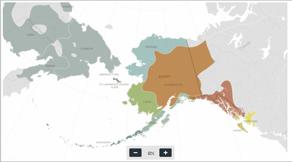 |
| Smithsonian Map online |
Given that the map is based on a careful analysis of individual speech patterns, it is natural to ask where all of this information on speech patterns was obtained. The answer is that Krauss himself collected much of the information firsthand through interviews with Native speakers.
Krauss began this project -- one that would become a lifetime effort -- immediately upon arriving in Alaska in 1960. In fact, arguably he began slightly earlier, for as soon as Krauss knew that he was going to Alaska (as a professor of French, of all things) he began an extensive review of existing literature and made contact with leading experts on Alaska languages, such as Harry Hoijer of UCLA.
While the main focus of Krauss' work during the 1960s was the documentation of the Eyak language, he never missed an opportunity to ask a speaker from a region with which he was not familiar how certain words were pronounced. Krauss estimates that perhaps half of this information was collected at the Alaska Native Service Hospital in 1962, requiring Krauss to communicate with TB patients from behind a surgical mask.
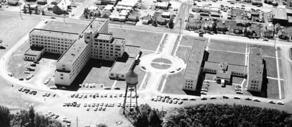 Essentially, what Krauss was compiling in the 1960s was a geographic language database.
Someone attempting such a project from scratch today would surely use GIS technology.
Lacking access to digital technology, Krauss compiled isoglosses using overlays drawn
on tracing paper. These original materials, which served as the basis for the printed
map, can be viewed at the Alaska Native Language Archive.
Essentially, what Krauss was compiling in the 1960s was a geographic language database.
Someone attempting such a project from scratch today would surely use GIS technology.
Lacking access to digital technology, Krauss compiled isoglosses using overlays drawn
on tracing paper. These original materials, which served as the basis for the printed
map, can be viewed at the Alaska Native Language Archive.
Language Names
One feature of the map that attracts much interest is the choice of language names. Some of the names on the map are considered to be improperly spelled (e.g., Kutchin rather than Gwich'in, or Tanaina rather than Dena'ina); are considered pejorative (e.g., Ingalik rather than Deg Hit'an, or Aleut rather than Unangax̂). At first glance, choosing a language name may seem a relatively simple task. Most Alaska Native languages, however, have no special name in the language itself for the language. This reflects a traditional view of language as something extremely local and personal. Rather than reflecting a political entity, Alaska Native languages typically reflected a very local way of speaking. When pressed for a way of naming their language, speakers of most Alaska Native languages use something that translates literally as "the language of people" or "the language of tribe X" or simply "our language." Recently, some of these terms have gained more or less official status through the efforts of language revitalization programs. Examples include:
Unangam Tunuu for Aleut (literally: peoples' language)
and
Denaakk'e for Koyukon (literally: like us)
While such terms are without doubt true to the Native language, their popularity is relatively recent.
Another issue that affects language names is whether to use an English name or an indigenous name. Most world languages receive special English names. Thus, we refer to French and German rather than Français and Deutsch. Some of the Alaska Native languages have followed this pattern. For example, Tlingit is to Łingít just as German is to Deutsch. Tlingit is the accepted English version of the language name. A related example is Ahtna, which is an English version of the Native word "atna." In this case the Native word refers not to the language but to the Copper River. In other cases, such Anglicization has been rejected. For example, the name Tanaina is today rejected in favor of Dena'ina, which is the same word but written in the indigenous orthography.
In some cases it can be difficult for a language community to reach a consensus on a language name. In the case of Tanacross, some have argued for the name Dihthaad Xt'een Iin Aandeg', which translates literally as "the language of the Mansfield people." This is a fine term, but it would seem to exclude speakers who do not come from Mansfield. This disagreement has had the effect of promoting the English term Tanacross.
Another example concerns Aleut. There has been much effort to replace this name with a Native word meaning "people." The only difficulty is that the plural suffix differs by dialect, so that the word for people is Unangan in the eastern dialect and Unangas in the western dialect. As a compromise, one can use the singular form Unangax̂, which is the same in both dialects. (That last character doesn't always display well; it is an x with a ^ on top.) This name has gained significant currency within the community and will likely appear on future editions of the Map.
We can recognize several categories of language names on the map. Names derived from places include:
- Holikachuk, from the name of a former village on the Innoko River
- Tanacross, from Tanana Crossing
- Tanana

- Upper Tanana
- Upper Kuskokwim
- Ahtna, from the Native word for the Copper River
Names derived from Native words include:
- Yup'ik, meaning 'real' or 'true' or 'genuine' person
- Inupiaq, meaning 'real' or 'true' or 'genuine' person
- Sugpiaq, meaning 'real' or 'true' or 'genuine' person
- Tlingit, from Łingít, meaning 'people'
- Dena'ina or Tanaina, meaning 'people'
- Deg Hit'an, meaning 'people of (this) region'
- Gwich'in or Kutchin, meaning 'people of ____'
- Han, meaning 'river'
- Tsimshian, from ts'msyan, meaning 'inside the Skeena River'
- Haida, from Xa'ida, meaning 'people'
Names derived from a combination of Russian and Native words include:
- Alutiiq, from the Russian word Aleut (a term something like English "Eskimo" but referring to the people of the Aleutian Islands, the Alaska Peninsula, and the Kodiak archipelago); plus the Russian plural suffix -y; plus the Native singular suffix -q
- Koyukon, from the Russian spelling Kuyukak of a Yup'ik word based on the root kuik meaning 'river'
Other languages?
It is sometimes asserted that certain language varieties exist as distinct languages but are not represented on the Map. Usually, this boils down to an issue of language versus dialect. Here I consider just a few cases.
Cup'ik
The term Cup'ik has been used in a variety of ways but generally refers to a speech variety in the region of Hooper Bay, Chevak, and Nunivak Island. The speech of these areas differs in several ways from that of other regions of Southwest Alaska, but the most noticeable difference is that the sound pronounced elsewhere as "y" is pronounced here as "ch" (spelled "c" in the writing system). Hence, while the word for person is "yuk" throughout most of Southwest Alaska, in Hooper Bay, Chevak, and Nunivak this word is pronounced "cuk". And so on with all the other "y" words.
While this difference between "y" and "c" may appear significant to an English speaker, it does not impede communication. This is because the alternation between "y" and "c" never leads to a difference in meaning. Because of this, Cup'ik is generally considered by linguists to be a dialect of Central Alaskan Yup'ik (actually two dialects, Hooper Bay-Chevak and Nunivak; the latter shows additional differences such as the pronunciation of "w" as "kw" in certain contexts). Unfortunately, while this difference between "y" and "c" is arguably minor, the fact that "y" occurs in the name of the language (whether Yup'ik or Yugcetun or Yupiaq) makes it extremely difficult for a speaker in Hooper Bay, Chevak, or Nunivak to accept Yup'ik as a name for her language.
The ultimate cause of this tension is the use of an alphabet that is more often used for writing English. In reality, Yup'ik has one sound that is pronounced by some speakers as "y" and others as "c" (and by still others somewhere in between). But by using a letter from the English alphabet (whether "y" or "c"), it is difficult not to subconsciously assign an English pronunciation. In theory, a Yup'ik speaker could simply pronounce "y" according to his local dialect. In practice, for speakers bilingual and even dominant in English, this is much more difficult.
Middle Tanana
Linguist James Kari has been a strong advocate for Middle Tanana, referring to the former language of the Salcha-Goodpaster bands along the middle Tanana River. On the map, this area is considered a dialect of Tanana, but it does indeed exhibit several distinctive features. In particular, unlike the Minto-Nenana dialect of Tanana (though like the Chena dialect), Salcha-Goodpaster does not maintain a distinction between Proto-Athabascan *ts and *tsw. Thus, in Minto-Nenana the words for 'yellow' (tsiyh) and 'cry' (trax) start with different sounds, whereas in Salcha-Goodpaster these words both start with ts. Kari notes several lexical differences as well.
But a single criterion is generally not sufficient to distinguish language. The crucial issue is one of mutual intelligibility, that is, whether speakers can understand one another. Speakers of Salcha-Goodpaster were clearly better able to understand Chena and even Minto-Nenana than Tanacross. Another issues has to do with language maintenance. It could be argued that recognizing Middle Tanana as a distinct language could contribute to language maintenance by supporting a distinct identity for Salcha-Goodpaster. It could equally well be argued, however, that including Salcha-Goodpaster as part of Tanana would encourage language revitalization by relieving the need to develop separate learning materials for Salcha-Goodpaster. With the passing in 1993 of Eva Moffit, the last speaker of the Salcha-Goodpaster dialect, this point has become largely moot.
This ambiguity is reflected in Krauss' classification of Lower Tanana:
Definition of the Lower Tanana language as such is probably the most arbitrary and problematical sociolinguistic decision that must be made in delimiting the Alaska Athabaskan languages. (Krauss & Golla 1981)
Languages that are no longer spoken
When the map was made, the intent was to include the Native languages spoken at that time in Alaska. With the passing of Marie Smith in early 2008, there are no longer any native speakers of the Eyak language, though we still consider it to be an Alaska Native language. The last speaker of Tsetsaut, an Athabascan language once spoken along Portland Canal in Southeast Alaska, passed away in the first half of the twentieth century. Tsetsaut is not included on the map, though it is just as much an Alaska Native language as is Eyak. Other languages, such as Alaskan Russian, that are found uniquely in Alaska are not included on the map because they are not always considered to be Native.
References
Krauss, Michael E. 1974(1982). Native Peoples and Languages of Alaska. Fairbanks: Alaska Native Language Center.
Krauss, Michael E. 1980. Alaska Native Languages: Past, Present, Future. Fairbanks: Alaska Native Language Center.
Krauss, Michael E. 2006. A history of Eyak language documentation and study: Fredericæ de Laguna in memoriam. Arctic Anthropology 43(2), 172-218.
Krauss, Michael, and Victor Golla. 1981. Northern Athapaskan languages. Handbook of North American Indians, vol. 6: Subarctic, ed. by J. Helm, 67-86. Washington, D.C.: Smithsonian.
Osgood, Cornelius. 1936. The Distribution of the Northern Athapaskan Indians. (Yale University Publications in Anthropology, no. 7). New Haven, CT: Yale University.
Shelikhov, Gregorii Ivanovich, and Richard A. Pierce. 1981. A Voyage to America 1783-1786. Kingston: The Limestone Press.
Tikhmenev, Petr Aleksandrovich. 1863. Istoricheskoe obozrienie obrazovaniia Rossiisko-amerikanskoi kompanii i dieistvii eia do nastoiashchago vremeni. St. Petersburg: E. Veimar.
| The above text is a work in progress. It represents an attempt to explain the story behind the Map. Feedback is very much welcome. Please post comments to the Alaska Native Languages Map blog. -- Gary Holton |


